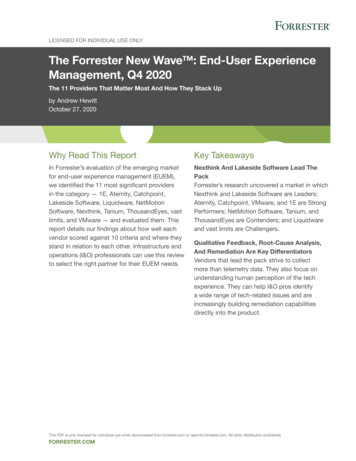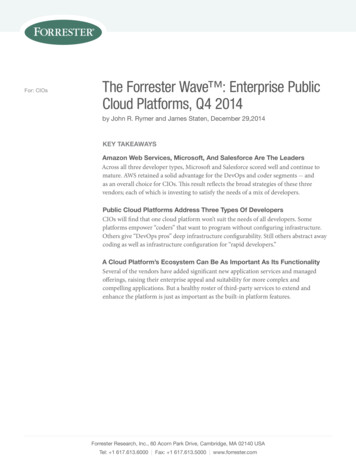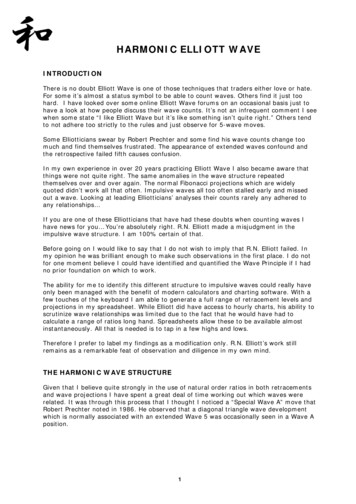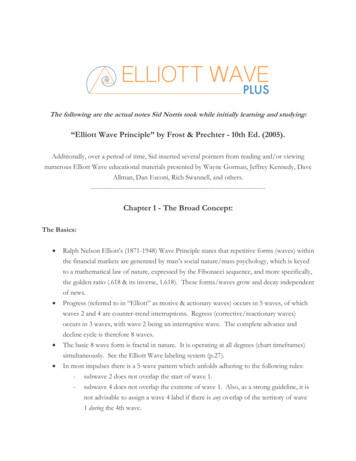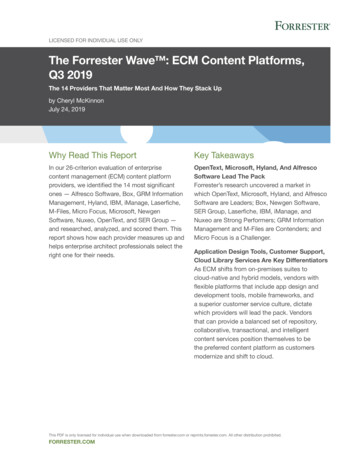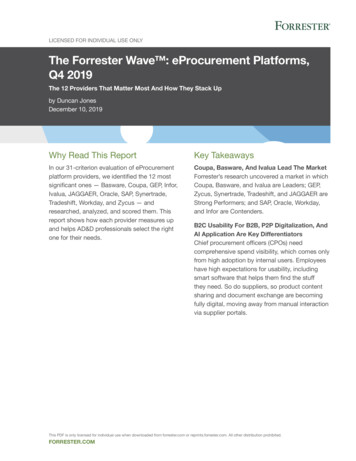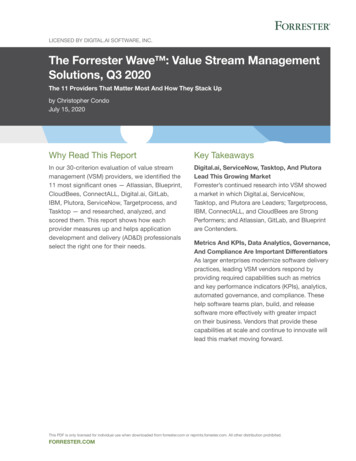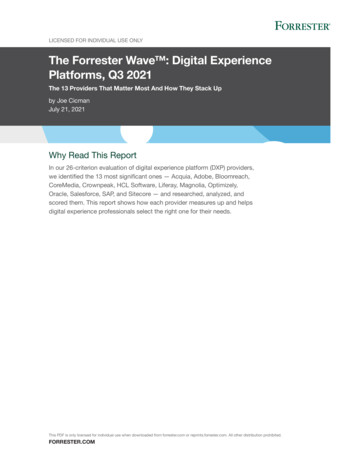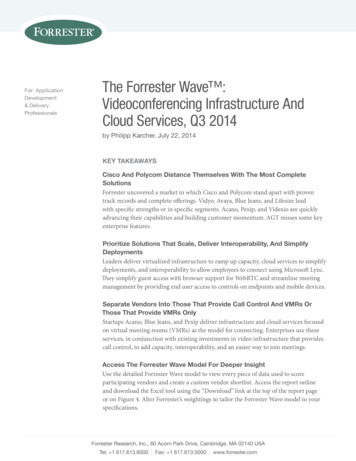
Transcription
For: ApplicationDevelopment& DeliveryProfessionalsThe Forrester Wave :Videoconferencing Infrastructure AndCloud Services, Q3 2014by Philipp Karcher, July 22, 2014Key TakeawaysCisco And Polycom Distance Themselves With The Most CompleteSolutionsForrester uncovered a market in which Cisco and Polycom stand apart with proventrack records and complete offerings. Vidyo, Avaya, Blue Jeans, and Lifesize leadwith specific strengths or in specific segments. Acano, Pexip, and Videxio are quicklyadvancing their capabilities and building customer momentum. AGT misses some keyenterprise features.Prioritize Solutions That Scale, Deliver Interoperability, And SimplifyDeploymentsLeaders deliver virtualized infrastructure to ramp up capacity, cloud services to simplifydeployments, and interoperability to allow employees to connect using Microsoft Lync.They simplify guest access with browser support for WebRTC and streamline meetingmanagement by providing end user access to controls on endpoints and mobile devices.Separate Vendors Into Those That Provide Call Control And VMRs OrThose That Provide VMRs OnlyStartups Acano, Blue Jeans, and Pexip deliver infrastructure and cloud services focusedon virtual meeting rooms (VMRs) as the model for connecting. Enterprises use theseservices, in conjunction with existing investments in video infrastructure that providescall control, to add capacity, interoperability, and an easier way to join meetings.Access The Forrester Wave Model For Deeper InsightUse the detailed Forrester Wave model to view every piece of data used to scoreparticipating vendors and create a custom vendor shortlist. Access the report onlineand download the Excel tool using the “Download” link at the top of the report pageor on Figure 4. Alter Forrester’s weightings to tailor the Forrester Wave model to yourspecifications.Forrester Research, Inc., 60 Acorn Park Drive, Cambridge, MA 02140 USATel: 1 617.613.6000 Fax: 1 617.613.5000 www.forrester.com
For Application Development & Delivery ProfessionalsJuly 22, 2014The Forrester Wave : VideoconferencingInfrastructure And Cloud Services, Q3 2014Cisco And Polycom Lead, Followed By Vidyo, Avaya, Blue Jeans,And Lifesizeby Philipp Karcherwith Stephen Powers, Khalid Kark, and Nathaniel FlemingWhy Read This ReportIn Forrester’s 24-criteria evaluation of videoconferencing infrastructure and cloud services vendors, weidentified the 10 most significant OEMs — Acano, AGT, Avaya, Blue Jeans Network, Cisco Systems,Lifesize, Pexip, Polycom, Videxio, and Vidyo — in the category and researched, analyzed, and scored them.This report details our findings about how well each vendor fulfills our criteria and where they stand inrelation to each other to help technology managers select the right videoconferencing infrastructure orservice for their environment.Table Of ContentsNotes & Resources2 Videoconferencing Infrastructure IncludesFive Key Capability SetsForrester conducted videoconferencinginfrastructure evaluations in March 2014 andinterviewed 32 vendor and user companies,including: Acano, AGT, Avaya, Blue JeansNetwork, Cisco Systems, Lifesize, Pexip,Polycom, Videxio, and Vidyo.2 Top Priorities: Scalability, Interoperability,And SimplificationCloud Services And Collaboration Platforms AreCritical Strategic ConsiderationsMost New Solutions Forgo Call Control ToFocus On Virtual Meeting Rooms7 Videoconferencing Infrastructure EvaluationOverviewFirst-Party Platforms And Standards SupportNarrow The Field11 Leaders Have Complete InfrastructureSolutions And Proven Scale14 Vendor ProfilesRelated Research DocumentsSee Me, Serve Me: Video Chat For CustomerService Starts To Take HoldApril 23, 2014Forrester’s Videoconferencing StrategyFrameworkFebruary 14, 2014The Forrester Wave : DesktopVideoconferencing, Q3 2013September 13, 2013LeadersStrong PerformersContenders17 Supplemental Material 2014, Forrester Research, Inc. All rights reserved. Unauthorized reproduction is strictly prohibited. Information is based on best availableresources. Opinions reflect judgment at the time and are subject to change. Forrester , Technographics , Forrester Wave, RoleView, TechRadar,and Total Economic Impact are trademarks of Forrester Research, Inc. All other trademarks are the property of their respective companies. Topurchase reprints of this document, please email clientsupport@forrester.com. For additional information, go to www.forrester.com.
For Application Development & Delivery Professionals2The Forrester Wave : Videoconferencing Infrastructure And Cloud Services, Q3 2014Videoconferencing Infrastructure Includes Five Key Capability SetsVideoconferencing infrastructure connects videoconferencing endpoints — the conference-roombased systems, desktop clients, and mobile apps people use to join meetings. Key infrastructurecapabilities include: Conference bridging and routing. The bridge, also known as a multipoint control unit (MCU),connects multiple endpoints, combining their streams into a single image and sending it backout. Alternatively, a switching architecture routes streams directly to the endpoints for mediaprocessing. Modern infrastructures use a combination of switching for efficiency and bridgingfor interoperability. Network services. Gateways, gatekeepers, and call control devices provide endpoint registration,device address translation, network translation, and firewall traversal services. In recent years,vendors have consolidated the number of these components into fewer boxes to improvemanageability. Interoperability. Videoconferencing infrastructure is an intermediary between different vendors’endpoints with their individually supported protocols and codecs for connecting. Infrastructurehandles interoperability by transcoding media in the MCU or in a separate gateway. Management controls. Management controls are important for configuring video quality andbandwidth policies, controlling security features, and provisioning users and devices. They alsoprovide live monitoring and management of calls in progress and historical reporting. Recording and streaming. Recording and streaming are useful for firms that want to turnconference rooms into broadcast studios or let employees catch up on meetings they missed.Leaders have full-fledged offerings that include content management features and rich videoportals.Top Priorities: Scalability, Interoperability, And SimplificationOrganizations are moving beyond justifying videoconferencing investments based on travelavoidance. Instead, by making it available to all their employees, with a simplified guest accessmodel for partners and customers, they can make the case that videoconferencing enhancescollaboration and improves business outcomes. Therefore, technology managers are prioritizingvideo infrastructure solutions that: Simplify the experience — for both admins and users. For years the video industry has soldcomplex infrastructure directly to customers. The upfront investment and expertise requiredwere prohibitive for small businesses and led many larger organizations to rely on managedservices. New video-as-a-service offerings in the cloud simplify the deployment model, as wellas strip out a lot of functionality. 2014, Forrester Research, Inc. Reproduction ProhibitedJuly 22, 2014
For Application Development & Delivery Professionals3The Forrester Wave : Videoconferencing Infrastructure And Cloud Services, Q3 2014 Scale videoconferencing to many participants. More organizations look to the cloud or tovirtualization as solutions for scaling up video capacity instead of buying the traditional digitalsignal processing (DSP) ASIC-based hardware. Another consideration is to use architectureoptimized for switching rather than transcoding in order to maximize efficiency in ahomogeneous endpoint environment. Some vendors have also improved the efficiency of theirinfrastructure deployed in a distributed architecture — increasing scale, reducing latency, andsaving bandwidth when participants in different locations are able to join via local nodes ratherthan all connecting directly to a single bridge.1 Address the expanding platform fragmentation. Videoconferencing managers face thechallenge of enabling the vision of any-to-any video connectivity by anyone, anywhere, on anydevice. As companies prioritize desktop video initiatives, the issue of platform fragmentationhas gotten more complex with customers having to worry about support for WebRTC indifferent browsers, apps on iOS and Android devices, and interoperability with third-partyapplications like Google Hangouts and Microsoft Lync.Cloud Services And Collaboration Platforms Are Critical Strategic ConsiderationsThe past year has seen an explosion of vendor activity in videoconferencing, characterized by thegrowth of cloud services, new vendors promoting scalable infrastructure offerings, and a strongeremphasis on video’s role in collaboration strategy with more approaches for extending video todesktops and mobile devices. Forrester sees: More providers moving to offer video-as-a-service (VaaS). Forrester data shows thatapproximately a third of firms would prefer to use a cloud or hosted deployment model forvideoconferencing (see Figure 1). Telcos like AT&T and systems integrators like DimensionData have bundled access to their hosted Cisco and Polycom infrastructure with managedservices. Conferencing specialists like Yorktel have added Vidyo to their list of hosted offerings.InterCall resells Blue Jeans. AVI-SPL has its own service based on Pexip, and IVCi is whitelabeling Videxio. The explosion of VaaS offerings has created a new set of considerations forbuyers — not only of whether or not to go to the cloud but also what the pros and cons are ofpartnering with different types of providers to get there. Traditional infrastructure vendors investing in their own video clouds. Avaya, Cisco, Lifesize,and Polycom have held off from pushing their own VaaS offerings to avoid channel conflict withtheir partners that are standing up these services themselves. However, many of those partnershave struggled with long lead times to get up and running and to continuously update theircloud services with the latest capabilities. Meanwhile, the success of Blue Jeans, which onlyallows its partners to resell access to its service, and the rapid adoption of VaaS overall haveforced the OEMs to expand their strategy. Lifesize Cloud now offers the full breadth of Lifesize 2014, Forrester Research, Inc. Reproduction ProhibitedJuly 22, 2014
For Application Development & Delivery Professionals4The Forrester Wave : Videoconferencing Infrastructure And Cloud Services, Q3 2014infrastructure capabilities. Cisco’s Collaboration Meeting Rooms (Cloud) will connect videoendpoints with WebEx in October. And Polycom is expanding its own white-label VaaS andmanaged services offerings. Virtual servers that can scale up capacity emerging. Acano, Cisco, Lifesize, Pexip, Polycom,and Vidyo have introduced virtual server options, finally bringing video in line with a standarddeployment model for IT infrastructure. However, vendors are at different stages of maturitywith their virtualized offerings, and their price/performance ratios don’t yet give a clearadvantage over purpose-built hardware. The customer references Forrester spoke to gave mixedreviews, with some deploying virtualized infrastructure today, others sticking to the traditionalmodel having evaluated both options, and others still investigating virtualization for their nextprovisioning cycle. Google and Microsoft making a stronger push to offer complete solutions. For firmschoosing Google Apps or Microsoft Lync for collaboration, these platforms have increased theirviability as self-contained desktop-to-conference-room video environments now with Google’sChromebox for Meetings and Microsoft’s Lync Room Systems designed to work in each of theirenvironments, respectively.2 While there are already many third-party infrastructure solutionsand services to enable interoperability with Microsoft Lync, Google Hangouts now also hasa gateway being provided by Vidyo. Forrester is starting to see some large-scale deploymentsof Lync Room Systems. However, both Lync Server and Google Apps are still immatureas videoconferencing infrastructure when it comes to interoperability, as neither supportsconnectivity with standards-based systems by themselves. Lync interoperability becoming a major priority. Forrester gets regular inquiries fromorganizations that want to use Microsoft Lync for desktop video about what their optionsare to connect with Cisco, Polycom, and other room-based endpoints. Most vendors in thisForrester Wave support bidirectional video but not content sharing with Lync. Some supportvideo interoperability with Lync Server but not Office 365. Comprehensive support for Lyncinteroperability weighs heavily in the value propositions for Acano, Blue Jeans, Pexip, andPolycom. At the time of this evaluation, Cisco didn’t support bidirectional content sharing withLync on the grounds that Microsoft uses a proprietary protocol, RDP — not standards likeH.239 or BFCP. However, due to customer demands, Cisco announced it will be adding supportlater this year. 2014, Forrester Research, Inc. Reproduction ProhibitedJuly 22, 2014
For Application Development & Delivery Professionals5The Forrester Wave : Videoconferencing Infrastructure And Cloud Services, Q3 2014Figure 1 One-Third Of Firms Would Prefer A Hosted Or Cloud-Type Service For Videoconferencing“In the future (your next provisioning cycle), how do you think yourfirm would prefer to manage or deploy the followingvideo technologies?”HD in-room videoconferencingOff-premises cloud-type/as-a-service(shared infrastructure)Self-provisioned13%and ucture)20%Outsourced or on-premisesmanaged CPE26%Desktop IP videoconferencingOff-premises cloud-type/as-a-service(shared infrastructure)Self-provisioned19%and ucture)17%Outsourced or on-premisesmanaged CPE25%Base: 521 to 594 global technology decision-makers whose firmsare planning to adopt or have adopted the above video technologiesSource: Forrester’s Business Technographics Global Networks And Telecommunications Survey, 2014112222Source: Forrester Research, Inc.Most New Solutions Forgo Call Control To Focus On Virtual Meeting RoomsVideo architecture and technology aside, at a high level the vendors separate into those whosefunctionality includes:1. Call control and virtual meeting rooms. Avaya, Cisco, Lifesize, Polycom, and Videxio canregister endpoints — assigning them phone numbers, email addresses, or extensions and addingthem to and provisioning them with the corporate directory. For multiparty calling, users candial directly into a VMR or escalate an existing point-to-point call into a conference. Vidyoprovides these services for its own but not for other vendors’ endpoints.2. Virtual meeting rooms only. To simplify the experience and promote adoption, Acano, AGT,Blue Jeans, and Pexip focus on VMRs as a single means of joining meetings. They do away withtraditional features like Exchange server integration to have scheduled meetings automatically 2014, Forrester Research, Inc. Reproduction ProhibitedJuly 22, 2014
For Application Development & Delivery Professionals6The Forrester Wave : Videoconferencing Infrastructure And Cloud Services, Q3 2014pop up on endpoints, have limited recording and streaming features, and have fewer optionsexposed to end users and admins in general. By focusing on VMRs, these vendors tackle thebiggest bottleneck — the MCU — in scaling up videoconferencing. Call control is important,but it is harder to get customers to replace their existing call control solutions (see Figure 2).Forrester sees more large enterprises choosing vendors in the first category as part of a platformdecision that displaces prior video investments and choosing vendors in the second category toaugment their existing infrastructure with another option to use for Microsoft Lync interoperabilityand/or scalability by provisioning VMRs to a large number of employees.Figure 2 Vendors Differ By Major Functionality And Commercial ModelsCall control VMR: Endpoint registration, call control, point-to-point via directory, and virtualmeeting roomsVMR only: Virtual meeting rooms onlyCall control VMRThirdCustomer partypremises hostedVMR onlyThirdpartyThirdresellingVendor- vendor- Customer partypremises hostedhosted hostedAcanoAGTAvayaBlue ostedThirdpartyresellingvendorhosted*Vidyo provides this for its own endpoints only.112222 2014, Forrester Research, Inc. Reproduction ProhibitedSource: Forrester Research, Inc.July 22, 2014
For Application Development & Delivery Professionals7The Forrester Wave : Videoconferencing Infrastructure And Cloud Services, Q3 2014Videoconferencing Infrastructure Evaluation OverviewTo assess the state of the videoconferencing infrastructure and cloud services market, Forresterevaluated the strengths and weaknesses of the top vendors to stack them up against each other.After examining past research, user need assessments, and vendor and expert interviews, wedeveloped a comprehensive set of evaluation criteria. We evaluated vendors against 24 criteria,which we grouped into three high-level buckets: Current offering. To assess the strength of the product offerings, we evaluated the vendorsbased on 13 criteria: 1) proven scale; 2) deployment flexibility; 3) distributed architecture; 4)availability and redundancy; 5) interoperability; 6) quality of experience; 7) scheduling features;8) ad hoc features; 9) in-meeting controls; 10) security; 11) management; 12) recording andstreaming; and 13) endpoints. We asked about, but did not score, licensing options. Strategy. We reviewed each vendor’s strategy in several areas: 1) proven scale in the cloud; 2)API strategy; 3) mobile strategy; 4) investment priorities; 5) call control; and 6) global presence. Market presence. To determine a vendor’s market presence, we counted each vendor’s overallcompany revenue, videoconferencing revenue, number of resellers and systems integrators,number of service providers, and number of product engineers.First-Party Platforms And Standards Support Narrow The FieldForrester included 10 vendors in the assessment: Acano, AGT, Avaya, Blue Jeans Network, CiscoSystems, Lifesize, Pexip, Polycom, Videxio, and Vidyo (see Figure 3). Each of these vendors has: Interoperability with standards-based room systems. Each of these vendors’ solutionssupports at a minimum SIP and H.323, which are broadly adopted standards for videointeroperability. We did not include Google Apps or Microsoft Lync, which rely on third-partysolutions — the vendors in this Forrester Wave — to connect to endpoints other than GoogleHangouts or Microsoft Lync, respectively. We also did not include Fuze and Zoom, which areprimarily video and webconferencing applications in the cloud but count interoperability withSIP and H.323 devices among their features. First-party infrastructure offerings. Many vendors actually resell, white-label, or stand up theirown services based on these evaluated vendors’ products. In this evaluation, Videxio uses theMCUs of Acano, Cisco, Pexip, and Polycom but has a proprietary call control and managementplatform. One notable vendor missing from the evaluation is StarLeaf, a video-as-a-serviceoffering with its own software and hardware endpoints. StarLeaf briefed Forrester after theediting deadline, so it was not included in the evaluation. 2014, Forrester Research, Inc. Reproduction ProhibitedJuly 22, 2014
For Application Development & Delivery Professionals8The Forrester Wave : Videoconferencing Infrastructure And Cloud Services, Q3 2014 Customer references. All of the participating vendors provided contact information for atleast two customers that agreed to speak to Forrester about their use of the videoconferencinginfrastructure or services solution. Sparked client inquiries and/or has a solution that put the vendor on Forrester’s radar.Forrester clients often discuss these vendors and products through inquiries; alternatively, thevendor may, in Forrester’s judgment, warrant inclusion in this evaluation because of technologytrends or their market presence. 2014, Forrester Research, Inc. Reproduction ProhibitedJuly 22, 2014
For Application Development & Delivery ProfessionalsThe Forrester Wave : Videoconferencing Infrastructure And Cloud Services, Q3 20149Figure 3 Evaluated Vendors: Product InformationVendorProduct evaluatedAcanoAcanoApplied Global TechnologiesEncoreB2BAvayaAvaya Scopia Elite 6000 Series MCUs8.3Avaya Aura Conferencing7.2.2Version1.5Blue Jeans NetworkBlue JeansCisco SystemsCisco Hosted Collaboration (HCS)10Cisco TelePresence VideoCommunication Server (VCS) Control8.1.1Cisco Expressway8.1.1Cisco TelePresence MCU4.4Cisco MSE 8000MCU 4.4 includes MSE 8510, MSE8050 Supervisor 2.3Cisco TelePresence Management SuiteTMS 14.4, TMSPE 1.2, TMSXE 4.0Cisco Unified Communications Manager 10Cisco WebEx Enabled TelePresenceWebEx Meeting Center T28, T29;CUCM 8.6.2 or higher; VCS x7.2.2or x8.1; TMS 14.3.1, TMSXE 3.1,TMSPE 1.1; TelePresence MCU4.4; TelePresence Server 3.0 orhigher, 3.1 for TSPCisco TelePresence Content Server(TCS)6.1Cisco TelePresence Server4Cisco Show and Share5.5Virtual Experience Infrastructure (VXI)Requires Cisco Jabber 9.1.4 (needto buy Jabber to get VXME)Cisco Media Experience EngineMXE 3500 3.3.2Cisco TelePresence ConductorXC2.3Lifesize, a division of Logitech Lifesize UVC ClearSea4.0.3Lifesize UVC Multipoint1.6.2Lifesize UVC Video Center2.2.5112222 2014, Forrester Research, Inc. Reproduction ProhibitedSource: Forrester Research, Inc.July 22, 2014
For Application Development & Delivery ProfessionalsThe Forrester Wave : Videoconferencing Infrastructure And Cloud Services, Q3 201410Figure 3 Evaluated Vendors: Product Information (Cont.)VendorProduct evaluatedLifesize, a division of Logitech Lifesize UVC ManagerVersion1.2.1Lifesize UVC Transit4.1.4Lifesize UVC Access1.5.5Lifesize Bridge 22002.3PexipPexip Infinity5PolycomPolycom RealPresence OneCloud Meeting Services (wholesale)Resource Manager8.1Distributed Media App (DMA)6.0.4Collaboration Server8.3CloudAXIS Suite1.4.0Content Sharing Suite1.2Platform Director1.5Access Director3.1Global QOS networkEndpoint subscriptionsVirtual meeting roomVidexioPersonal video accountGlobal QOS networkEndpoint subscriptionsVirtual meeting roomVidyoPersonal video y3.0.2112222 2014, Forrester Research, Inc. Reproduction ProhibitedSource: Forrester Research, Inc.July 22, 2014
For Application Development & Delivery Professionals11The Forrester Wave : Videoconferencing Infrastructure And Cloud Services, Q3 2014Leaders Have Complete Infrastructure Solutions And Proven ScaleThe evaluation uncovered a market in which (see Figure 4): Cisco and Polycom differentiate themselves with the most complete solutions. Cisco andPolycom’s install base represents the lion’s share of the video infrastructure market, and theyhave the largest customer deployments — both on premises and in the cloud. They have themost comprehensive infrastructure offerings from call control to recording and streaming. Theysupport the most deployment options, which range from purpose-built hardware to virtualizedsoftware, and they offer their own VMR cloud services directly and their more comprehensiveportfolios of offerings hosted by service providers globally. Vidyo, Avaya, Blue Jeans, and Lifesize round out the Leaders. Vidyo has the most scalablesolution and the best video quality on non-guaranteed networks. Avaya has a completeinfrastructure offering with an emphasis on scaling up capacity for desktop and mobile endpoints.Blue Jeans is the leading video-as-a-service vendor due to its track record with large customerdeployments and the best support for interoperability. Lifesize has a comprehensive portfolio thatincludes leading recording and streaming capabilities, a mature virtualized infrastructure offering,and an integrated endpoint-plus-cloud-services experience direct from the manufacturer. Acano, Pexip, and Videxio offer competitive options. All of these providers’ products arenew on the market in the past 18 months and are achieving rapid success. Acano has a uniqueWebRTC collaboration experience, leading interoperability, and scalability. Pexip has stronginteroperability and more customer references taking advantage of its virtualization anddistributed architecture capabilities. Videxio’s innovative cloud service has a unique wizardthat automates registering endpoints, and it overcomes shortcomings of other cloud services byoffering call control features in addition to strong support for interoperability. AGT has a low-cost offering. AGT warrants a look as an easy-to-deploy cloud service withinteroperability support for standards-based systems and desktop, mobile, and hardwareendpoints available. AGT has less support than other providers in the Forrester Wave for somefeatures of interest to large enterprises like support for Microsoft Lync and distributed architecture.This evaluation of the videoconferencing infrastructure and cloud services market is intendedto be a starting point only. We encourage clients to view detailed product evaluations and adaptcriteria weightings to fit their individual needs through the Forrester Wave Excel-based vendorcomparison tool. 2014, Forrester Research, Inc. Reproduction ProhibitedJuly 22, 2014
For Application Development & Delivery Professionals12The Forrester Wave : Videoconferencing Infrastructure And Cloud Services, Q3 2014Figure 4 Forrester WaveTM: Videoconferencing Infrastructure And Cloud Services, Q3 ongCisco tofferingBlue JeansNetworkPexipGo to Forrester.com todownload the ForresterWave tool for moredetailed productevaluations, featurecomparisons, andcustomizable rankings.AGTMarket presenceWeakWeakStrategy112222 2014, Forrester Research, Inc. Reproduction ProhibitedStrongSource: Forrester Research, Inc.July 22, 2014
For Application Development & Delivery Professionals13The Forrester Wave : Videoconferencing Infrastructure And Cloud Services, Q3 2014Forrester’sWeightingAcanoAGTAvayaBlue Jeans NetworkCisco SystemsLifesizePexipPolycomVidexioVidyoFigure 4 Forrester WaveTM: Videoconferencing Infrastructure And Cloud Services, Q3 ’14 (Cont.)CURRENT OFFERINGProven scaleDeployment flexibilityDistributed architectureAvailability and redundancyInteroperabilityQuality of experienceLicensing optionsScheduling featuresAd hoc featuresIn-meeting controlsSecurityManagementRecording and 4.00STRATEGYProven scale in the cloudAPI strategyMobile strategyInvestment prioritiesCall controlGlobal 001.003.003.00MARKET PRESENCECompany revenueVideoconferencing revenueResellers and systemsintegrators (SIs)Service providersProduct engineersAll scores are based on a scale of 0 (weak) to 5 (strong).Source: Forrester Research, Inc. 2014, Forrester Research, Inc. Reproduction ProhibitedJuly 22, 2014
For Application Development & Delivery Professionals14The Forrester Wave : Videoconferencing Infrastructure And Cloud Services, Q3 2014Vendor ProfilesLeaders Cisco Systems continues to crunch the stack. Cisco continues its journey to unify its variousplatforms for communication. To simplify connectivity between video endpoints and WebEx,it announced the Collaboration Meeting Rooms (CMR) service in the cloud, in addition toon-premises options. It simplified licensing for unified communications (UC) and videoand continues to push video customers to move from its legacy VCS Control infrastructureand adopt the Call Manager platform, which integrates video with other Cisco UC services.Although the story is getting simpler, it is still complex. As Cisco repositions VCS Control, ithas invested in Expressway, a key component to manage firewall traversal, and now allowsremote employees to connect without a VPN — a complaint from our previous evaluation.TelePresence servers, Cisco’s MCUs, are now available as virtualized software, and Cisco ispushing regular updates to improve their performance. Cisco shines for adopters of the broaderCisco UC portfolio. Polycom makes a strong push into the cloud. Polycom thrives on its strong go-to-marketpartnership with Microsoft, delivering endpoints and infrastructure with native Lyncinteroperability. This past year Polycom bolstered its cloud strategy on multiple fronts. After aslow start, its CloudAXIS
Videoconferencing infrastructure connects videoconferencing endpoints — the conference-room-based systems, desktop clients, and mobile apps people use to join meetings. . provide live monitoring and management of calls in progress and historical reporting. . InterCall resells Blue Jeans. AVI-SPL has its own service based on Pexip, and .




